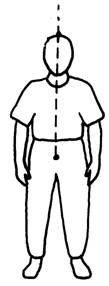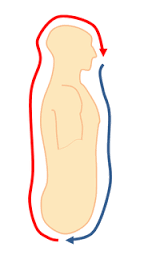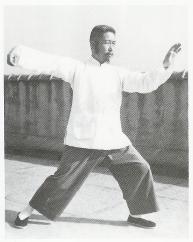Stances
There are 3 basic stances you will find within the Tai Chi form, these are then repeated. By familiarizing yourself with them practicing the form becomes easier. Once the base or the feet are correct its far easier to correct everything else. So lets take a look at the three stances.
Wuji Stance
This is the basic standing posture found at the beginning and end of the form. Although it may be easy to overlook this posture it is generally recognized as the most important posture in the whole form. This posture allows the correct alignments to be achieved more easily. This feeling can then be incorporated into the rest of the form.
To practice this posture please refer to the 3 bows exercise
As well as the three bows exercise here are some important points to be aware of.
- Feel as if the top of the head is being suspended from above, allowing the body to naturally relax and sink down.
- The tongue is placed on the roof of the mouth. To do this say the letter N. The tongue is placed here to connect the Du and Ren channel. These channels run up the spine and down the midline respectively. The tongue helps to connect the two channels and allows the Qi to run smoothly around the two channels.
- The shoulders should be relaxed and kept down in the shoulder joint. If the shoulder raises the arms lose connection with the body. A little tip that can help is to concentrate on the elbows. If they are relaxed and pointing down the shoulders will naturally be relaxed.
- Breath to the lower Dan Tian. Click here for more information on BREATHING
- the hips should be relaxed and soft. When relaxed the hips help to connect the upper and lower body, however they only do this when relaxed.
- The knees and elbows should never be completely straightened, always leave a natural curve in both the elbow and knee joint, this allows the Qi to flow smoothly.




The Bow Stance
This stance is repeated numerous times within the Tai Chi form. If you take a look at the pictures opposite you can see that the arm positions may change but the basic stance remains. We can see in the third picture that Cheng Man Ching's stance had gotten a little smaller as he aged and the whole posture in general looks more relaxed.
To practice the bow stance think of a rectangle on the floor. You have the heals of your feet on two of the corners and the long section of the rectangle is stretched out in front of you. Now place your left heal on the front left corner. The distance you step out is up to you, again look at the 2nd and 3rd picture, the posture is the same but the stance is smaller. A smaller stance can often be an advantage as it makes it easier to relax. My advice would be step out where it feels comfortable for you to do so.
Once the feet are in place we distribute the weight into the feet. Again here we have a choice, within this style we can place 70% of our weight into the front leg and 30% into to the back. However, within the Huang Xiang Xian lineage the weight is distributed almost 50-50 with just a little more in the front leg. Personally I prefer the second approach, its far easier to develop root with a 50-50 stance and it prevents the knee from going over the toes, something than can happen in a 70-30 stance if we are not careful. Opposite we can see a picture of Wee Kee Jin in a more 50-50 stance for comparison.




The following video is an exercise that takes you through all three main stances.
False Stance
The False stance basically means all the weight is in one leg, although it may not appear to be from the outside. In the first two postures shown the empty leg (the leg with no weight) is still touching the floor and so may give the appearance that body weight is still applied. However in both these stances the front foot can be picked up without any movement in posture or weight distribution.
This posture is repeated many times during the form. The hand positions may change and sometimes the empty leg is completely lifted up as in the third picture.


